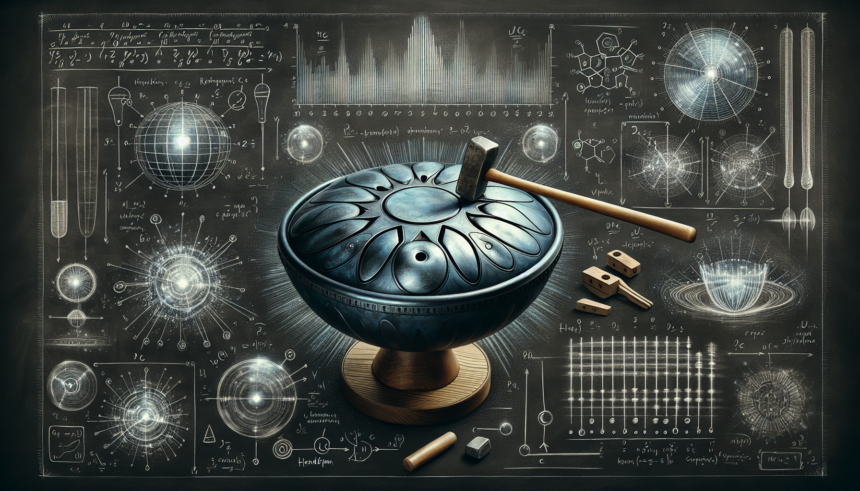The handpan, a relatively recent addition to the musical world, is renowned for its ethereal, captivating sound that belies its modest appearance. Shaped like a flying saucer, this instrument produces complex harmonic overtones that engage and mesmerize. Central to the handpan’s allure is its tuning—a meticulous process that ensures each note sings in just the right way. To truly appreciate the handpan, it helps to delve into the intricate science of its tuning, uncovering what makes this instrument so special.
The Anatomy of a Handpan
To understand handpan tuning, one must first understand the instrument’s construction. A handpan consists of two metal hemispheres glued together. The top side, known as the ‘ding’ side, has a central note surrounded by a circle of tonal areas known as ‘tone fields.’ These tone fields are carefully shaped dimples tuned to specific pitches. The bottom half, or ‘gu’ side, features a central hole often used for resonance and sometimes includes additional tone fields.
Basic Principles of Tuning
Tuning a handpan involves adjusting several factors: the shape, size, and tension of each tone field. When a tone field is struck, it vibrates at a specific frequency, producing a fundamental pitch. The metal’s material and thickness, as well as the precise curvature of each tone field, all contribute to this pitch. Here are some basic principles:
- Frequency and Pitch: The frequency at which a tone field vibrates determines its pitch. Higher frequencies produce higher pitches, while lower frequencies yield lower pitches.
- Overtones and Harmonics: Each fundamental pitch generates a series of overtones or harmonics. The first overtone is typically an octave above the fundamental note, while the second overtone is a fifth above the first, and so on. Together, these overtones contribute to the handpan’s rich, layered sound.
- Shape and Tension: The curvature and tension of each tone field must be meticulously adjusted. Slight changes can drastically affect the produced pitch and its associated overtones.
The Tuning Process
Tuning a handpan demands both artistry and precision. The process generally involves the following steps:
- Initial Shaping: Before tuning begins, the handpan’s metal shell is shaped and cut. Each tone field is carefully hammered to form the required dimples.
- Rough Tuning: In this phase, each tone field is initially tuned to approximate frequencies. This rough tuning sets the groundwork for more precise adjustments later on.
- Fine Tuning: Using hammers, pressure tools, and sometimes heat, the tuner makes minute adjustments to each tone field. This stage demands acute hearing and expertise, as small changes have significant impacts.
- Harmonic Tuning: Beyond tuning the fundamental pitch, tuners ensure that the overtones harmonize correctly. This involves striking different parts of the tone field and adjusting its shape to balance the harmonic spectrum.
It’s important to note that handpan tuning is often a cyclical process. Even minor adjustments can affect neighboring tone fields, necessitating repeated rounds of tuning to achieve the desired sound profile.
Challenges in Handpan Tuning
Tuning a handpan is an intricate art fraught with challenges. Here are some of the most significant difficulties tuners face:
- Material Variability: Handpans are typically made from nitrided steel or stainless steel, materials that can vary in their properties. Differences in metal composition, thickness, and treatment can all affect tuning.
- Complex Harmonics: Balancing the fundamental pitch with its harmonics requires acute precision. Imbalances can lead to an unwanted ‘beating’ effect where overtones clash.
- Environmental Factors: Temperature and humidity can influence metal tension, subtly altering pitches. Tuners must account for these variables, often tuning in controlled environments.
- Structural Integrity: Over-adjusting tone fields can lead to metal fatigue or, worse, cracking. Skilled tuners can achieve the desired notes without compromising the instrument’s durability.
Technological Aids in Tuning
While traditional handpan tuning relies heavily on human skill and the tuner’s ear, technology has begun to assist this meticulous process:
- Electronic Tuners: Devices that measure pitch frequency help tuners achieve precise tones. These tools can display real-time frequency information, guiding adjustments.
- Software Analysis: Acoustic analysis software can analyze the harmonic spectrum of each tone field, providing visual feedback on balance and suggesting corrections.
- Pressure Tools: Hydraulic and pneumatic tools offer consistent pressure, aiding in shaping tone fields uniformly and reducing human-induced variability.
- Thermal Tools: Heat application can temporarily soften the metal, allowing more precise adjustments without damaging the instrument.
Conclusion
The science behind handpan tuning reveals a complex interplay of physical properties and human artistry. From understanding the fundamental principles to navigating the challenges and employing technological aids, achieving the perfect tune is a labor of love. It is a testament to the skill and dedication of the craftsmen who create these instruments, ensuring that every handpan resonates with the enchanting sound that captivates so many. As we listen to the soothing melodies of a handpan, we can appreciate not just the music, but the intricate science and craftsmanship that bring it to life.
FAQs
- What is a handpan?
A handpan is a percussion instrument made from two metal hemispheres glued together, producing musical notes when struck. It features a central note and various surrounding tone fields, allowing for a range of pitches.
- How are handpans tuned?
Handpans are tuned by adjusting the shape, size, and tension of each tone field to achieve specific frequencies and harmonics. This involves a combination of hammering, pressing, and sometimes heating the metal.
- Why is handpan tuning difficult?
Tuning a handpan is challenging due to the need for precise control over metal properties and the balance of fundamental pitches with harmonic overtones. Factors like material variability and environmental conditions further complicate the process.
- Can technology help in handpan tuning?
Yes, electronic tuners, software for acoustic analysis, pressure tools, and thermal tools can assist tuners by providing precise measurements, consistent shaping, and controlled adjustments.
- What makes a handpan’s sound unique?
The handpan’s unique sound comes from its harmonic richness, produced by carefully tuned fundamental pitches and their overtones. The instrument’s shape and the material’s characteristics also contribute to its distinct ethereal quality.





